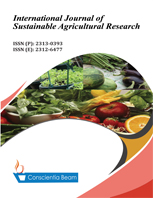Comparative Analysis of Technical Efficiencies of Smallholder Vegetable Farmers with and Without Credit Access in Swazil and the Case of the Hhohho Region
DOI:
https://doi.org/10.18488/journal.70/2015.2.4/70.4.133.145Abstract
The purpose of the study was to determine and compare the technical efficiencies of smallholder vegetable farmers in the Hhohho region of Swaziland. Data were collected from farmers through a structured questionnaire, which was administered using personal interviews. A two-stage sampling procedure was used by stratifying the vegetable farmers in the Hhohho region according to the four Rural Development Areas (RDAs) in the region. This was followed a random sampling technique used to select the number of vegetable farmers from each stratum. A sample size of 120 farmers was selected from a population of 289 vegetable farmers. Descriptive statistics and a Cobb-Douglas production function were used to analyze the data using the STATA program (version 12). The results revealed that tomato yield was positively associated with the amount of chemicals used, while cabbage yield was positively related to seed, and fertilizer. Beetroot has positive relationship with amount of fertilizer and labour, but a negative association with the amount of land used. The yield of green pepper was negatively related to fertilizer and positively related to chemicals and amount of land used. The technical efficiencies of tomato and cabbage farmers were affected by age, education level, farming experience and access to credit (p <0.01), while beetroot and green pepper was affected by farmer’s age, and off-farm income (p <0.05). The study recommended that vegetable farmers should increase the amount of seeds, fertilizer and chemicals used in order to improve yields. The Swaziland of Swaziland should subsidize farming inputs and financial institutions should make credit easily available to vegetable farmers in order to improve the efficient use of input resources.

